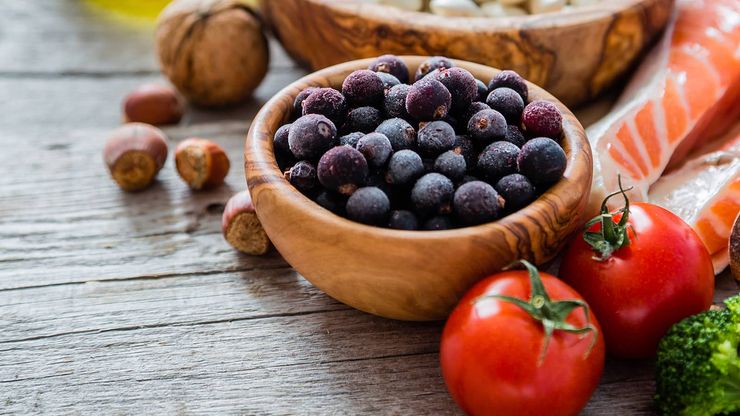Tips from @Joesgarden, author of Garden to Save the World
Help save the planet with these gardening tips from Joe Clark, a.k.a. @Joesgarden.

With over 1.6 million followers on TikTok @Joesgarden, and a community and online shop, Joe Clark is passionate about gardening and sustainability and committed to making it accessible to all. His new book, Garden to Save the World is part of this mission. Packed with practical advice, easy-to-understand instructions and beautiful illustrations, Joe shows us how to make a difference to our environment by transforming our gardens – no matter their size – into mini supermarkets.
Here, we share just a few tips from Joe's book, including how to make sure your plants are watered when you're on holiday and how to grow peppers at home.
How to grow food using food scraps
- Tie the ends of your spring onions together and put them in water. After a few days they will completely regrow.
- Instead of throwing away the ends of your celery, pop it in some water or plant it in some soil. In a couple of weeks, you will have a whole new celery ready for eating.
- Take a fresh stem from your herb packet, remove the bottom leaves and put it in some fresh water. After a couple of weeks it will develop its own roots. This works for a range of herbs!
- Take a few seeds from a ripe pepper and plant them in an old fruit punnet, give them a good water. After a few weeks, they will germinate.
How to fill raised beds and pots
Raised beds are a great way to grow fresh food at home. However, they can be very expensive to fill with soil. However, rather than filling up the entire container with soil, line the bottom with cardboard to suppress the weeds and add a mixture of organic materials. This can include twigs, wood compost and means you only need soil for the top of the bed.
Some of the benefits of raised beds:
- Raised beds can be easily made for free, using old pallet wood.
- They give you a balance between growing in pots and growing in open soil.
- If you avoid using garden soil to fill them up, you should not have a problem with weeds.
- Raised beds can look neat and attractive.
- More often than not, they are made from wood or metal, which helps you to avoid using plastic plastic.
- Raised beds are fantastic for people with mobility issues, especially wheelchair users, or those less able to spend prolonged amounts of time bending down.
- As raised beds are slightly elevated off the floor, they will offer a little bit of ground frost protection.
- The soil in raised beds often warms up faster in the spring, allowing you to sow your crops a little bit earlier.
How to water your plants on holiday
@joesgarden Today we are back and I am showing you my quick tip on how to water your plants if you are going away or are on holiday for a few days. This technique is really effective and will work really well, so well in fact you need to make sure your pots have drainage holes in the bottom for any excess moisture. I normally use a big bucket, rather than a suacepan, but it looked really bad on the video. Obviously this method is designed for plants inside or in a greenhouse, but if like me you have no rain forecast while you are away, you can use it for your outside plants too. Please be aware if the container is in direct outside sun, it can evaporate quite fast, so it is good to put it in some shade. I think it is best to use a thick cotton string as it absorbs water way better, but if you only have thin string, try weaving them together to make a thicker bit. Containers are a great way to grow crops and as a result I have launched garden with Joe! Each month I will send you all the seasonal seeds I am growing, plus all the supplies you need to grow them from sowing to harvest. All of this is in a sustainable and beginner friendly way! If you would like to join the growing family, check out the link in my profile that says garden with Joe. Thank you all so much for watching! I love you all, Joe 😊🌱💚 #organic #garden #gardening #growyourownfood #plantbased #sustainable #diy #zerowaste #gardentips #wateringplants ♬ Married Life (From "Up") - Geek Music
- Place a container in an elevated position and fill it up with some water.
- Cut some lengths of string and soak it in the water. Attach one end to a weight to keep it submerged.
- Place the plants around the container making sure they are lower than the water and drape the string into the plants, poking the ends into the soil.
- The water will gradually hydrate the plants via the string and stop them from drying out.
Other ways to be water-wise in the garden:
- Use smaller watering cans. They are less likely to spill and easier to aim.
- Where possible use watering cans rather than a hosepipe. Often the water coming out of you hose is clean-treated mains water. This water is of a quality that is simply wasted on your plants, and can even hamper their growth.
- Make sure to aim the water down to where the roots are. Water that lands on the leaves will evaporate.
- Give priority to your newly planted plants, as these will always require more water than plants that are already established.
- Remove as many weeds as possible as they create competition for moisture.
- Some plants are more drought-resistant than others, so consider this when planning your garden.
How to grow fresh peppers at home
- Remove the label from an old food container and poke some holes in the bottom for drainage.
- Sow some soil into the container and plant a few pepper seeds one to two centimeters deep.
- Water well and then close the lid to create a mini greenhouse effect.
- After a few weeks, plant them into individual pots. Move them again once they are bigger still.
- Once white flowers appear, the peppers are on their way. Harvest them young if you like them green, or leave them longer if you prefer them red.
Some gardening equipment that @Joesgarden recommends:
- A good pair of gloves
- Secateurs or plant snips
- Hand trowel
- Plant labels
- Two watering cans - one small and one large, both with rose attachments
- Water butt to collect rainwater
- Seed dibbler
- Kneeling pad
Joe's ultimate garden plant
‘There are some plants certain creatures cannot resist. A great example of two of these plants are nasturtiums and marigolds . . . You can plant these and other sacrificial plants next to your crops, and this will help to keep these little critters off the prized plants.’
— Joe Clark
Some extra gardening dos . . .
- Wait until the soil has warmed up, before planting outside. A general indicator that your soil is getting warmer is when little weeds start to appear.
- If growing in containers, make sure they have drainage holes.
- Enrich your soil by adding lots of organic matter.
- Give your plants plenty of room to grow.
- Harvest regularly, as this will prompt some crops to produce more.
- Encourage wildlife such as frogs and hedgehogs into your vegetable patch, as they will act as natural 'pest' control.
- Water in the mornings or evenings to prevent evaporation when the sun is at its warmest.
. . . and don'ts
- Grow large varieties in small containers.
- Try to grow crops that are not suited for your climate.
- Sow all of your seeds at once as this will often lead to a glut of food all in one go.
- Use peat-based composts.
- Trample the dug soil after planting.
- Use very old seeds as the germination rate will be much lower.
- Put too much pressure on yourself!
Want more tips?
Garden to Save the World
by Joe Clark
If you're looking for more tips and tricks on how to garden effectively and efficiently and save the world at the same time, Joe Clark's new book is just the ticket. With beautiful illustrations and easy-to-understand instructions and growing tips, this is the perfect book for budding or seasoned nature lovers who want to use their green-fingers to make a difference, no matter how much space you have.



